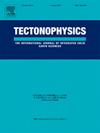Small-scale heterogeneities near the upper and lower mantle boundary beneath subduction zones
IF 2.6
3区 地球科学
Q2 GEOCHEMISTRY & GEOPHYSICS
引用次数: 0
Abstract
Small-scale compositional heterogeneity near the upper and lower mantle boundary below circum-Pacific subduction zones is investigated. We array-process seismograms of deep earthquakes recorded by large-aperture seismic networks at western US, Japan, and Alaska with the aim of examining anomalous signals in the P coda until about 35 s after direct P wave. The signals arrive from the directions close to the direct P wave. The signal amplitudes decay with delay time after the direct P wave and the decay feature apparently depends on focal depth. The signals most likely arise from S-to-P and P-to-P scattering within the lower and/or upper mantle around the foci. We show by applying a stochastic scattering theory for randomly heterogeneous media that the observations are matched well by density and rigidity anomalies of spatial scale on the order of 10 km, which diminish below about 700 km depth. The observations are matched if the rigidity anomaly is of the same sign and three to four times as large as the density anomaly. These properties of the scattering objects could be consistent with the predicted elastic anomalies of basalt near the upper and lower mantle boundary relative to the surrounding mantle of pyrolytic composition. The estimated weak degree of density heterogeneity, on the order of 0.01 to 0.1 %, may reflect sparse distribution of basaltic material of 10 km scale in the uppermost 100 km of the lower mantle possibly resulting from the significantly smaller density of basalt than the surrounding rock.
俯冲带上下地幔边界附近的小尺度非均质性
研究了环太平洋俯冲带上下地幔边界附近的小尺度成分非均质性。本文对美国西部、日本和阿拉斯加的大孔径地震台网记录的深地震进行了阵列处理,目的是研究直震波后35秒左右的P尾异常信号。信号从接近直接P波的方向到达。直接P波后信号振幅随延迟时间衰减,衰减特征明显依赖于震源深度。这些信号很可能来自于震源周围的下地幔和/或上地幔内的S-to-P和P-to-P散射。应用随机非均匀介质的随机散射理论,我们发现在10 km量级的空间尺度上的密度和刚度异常与观测结果吻合良好,在约700 km深度以下密度和刚度异常减小。如果刚性异常具有相同的符号并且是密度异常的三到四倍,则观测结果是匹配的。这些散射物的性质与预测的玄武岩在上下地幔边界附近相对于周围地幔的弹性异常是一致的。估计的密度非均质性弱程度在0.01 ~ 0.1%之间,可能反映了下地幔最上面100 km处10 km尺度玄武岩物质的稀疏分布,这可能是由于玄武岩密度明显小于围岩。
本文章由计算机程序翻译,如有差异,请以英文原文为准。
求助全文
约1分钟内获得全文
求助全文
来源期刊

Tectonophysics
地学-地球化学与地球物理
CiteScore
4.90
自引率
6.90%
发文量
300
审稿时长
6 months
期刊介绍:
The prime focus of Tectonophysics will be high-impact original research and reviews in the fields of kinematics, structure, composition, and dynamics of the solid arth at all scales. Tectonophysics particularly encourages submission of papers based on the integration of a multitude of geophysical, geological, geochemical, geodynamic, and geotectonic methods
 求助内容:
求助内容: 应助结果提醒方式:
应助结果提醒方式:


